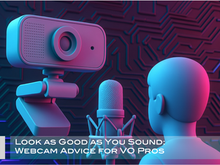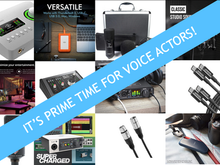Distance Matters! Why Mic Placement is Critical!
- Frank Verderosa
- May 5, 2024
- 3 min read
Updated: Nov 18, 2025

Voice coaches love the classic “hang 10” hand sign for mic distance. And sure, it looks cool and surfer-zen or whatever, but I once made a TikTok joking “Tell me you’re new to voice acting without telling me you’re new,” and just held that pose in front of the mic.
Because here’s the thing: what works in a professional studio doesn’t always translate to your home booth… no matter how much money, foam, blood, sweat, or PVC pipe you threw at it. That pinky-to-thumb distance? In your booth at home, it’s probably doing you dirty. Let’s talk about why.
Most of you need to unlearn this one.
In my Home Studio Primer class, we talk about comb filtering — the super fun phenomenon where your mic is too close to a wall or surface, sound bounces around like a toddler on sugar, and half those reflections cancel each other out by the time they hit the mic.
What you get is that dreaded “hollow” sound. And no, you can’t EQ your way out of hollow. Once it’s baked in, it’s baked in.
Then there’s the other classic issue: under-treated booths. A lot of folks treat the wall behind the mic but completely ignore the wall behind them. That’s actually the bigger culprit. When that area is bare, you get that “boxy” tone — like you’re reading copy from inside a storage bin.
And yes… sometimes I get a lovely combo platter: mic jammed right up against a wall and a booth that’s missing half its treatment. Hollow and boxy. A true acoustic smoothie.
But the good news? A lot of this is fixable just by moving the mic and adjusting your distance. Which brings us back to ditching the hang-10 thing.

Alright, giggle break over! Let's talk mic placement!
Mic placement is a game of inches — every inch matters. You’ll hear the sweet spot when you hit it. Singers know this feeling: when the harmony locks in and your chest buzzes like you just aligned with the universe for a second. You can have that same relationship with your microphone.
Once you find that “ahhh, there it is” spot, burn it into your brain. Then play with it:
Want an intimate, whisper-in-your-ear read? Lean in and use the proximity effect.
Want a chill, conversational vibe? Back off a smidge.
Want to avoid your booth flaws sabotaging your audition? Stay in the pocket you found.
And this applies whether you’re recording in a StudioBricks palace, a WhisperRoom, a carefully treated closet, or a cozy little PVC-and-blanket fort you engineered at 11pm.
If you ever want a quick set of ears on your setup, I do 15-minute sound checks to go through this stuff with you. But if you only take one thing from this whole post?
Mic placement matters. Every. Single. Inch.
Frank Verderosa is an award-winning audio engineer and voiceover casting director with decades of industry experience. As the owner of POV Audio, he casts, sound-designs, and mixes television, radio, and promo campaigns for leading ad agencies and networks. Outside the studio, Frank supports the voice actor community through coaching, consulting, and demo production for talent at every level. To connect or learn more, visit www.frankverderosa.com and use the chat tab or explore the Voice Actor Services section.






























Comments